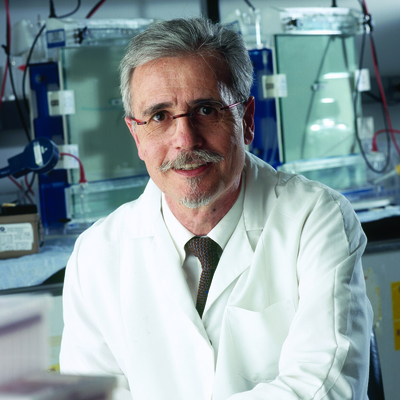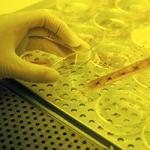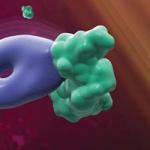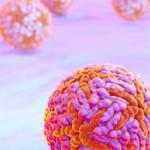
Research Topics
Dr. Pommier is internationally recognized for his contributions to the molecular pharmacology of topoisomerase inhibitors, and for the discovery and development of the non-camptothecin topoisomerase I (TOP1) inhibitors (Pommier, Y. et al, Nat Rev Mol Cell Biol 2016; Thomas & Pommier, Clin Cancer Res 2019). Three of his indenoisoquinoline TOP1 inhibitors are in Phase 1/2 clinical development (Thomas & Pommier, Clin Cancer Res 2019): LMP400 (Indotecan), LMP776 (Indimitecan) and LMP744. All show potent activity in the Comparative Oncology Trial Consortium (COTC) (Burton, J. et al, Clin Cancer Res. 2018) and in PDX models of triple negative breast cancers (TNBC) (Coussy et al, Sci Transl Med. 2020). Based on their promising clinical activity and their superior medicinal properties over the camptothecins, the indenoisoquinolines represent the first non-camptothecin TOP1 inhibitors for the treatment of cancers. Dr. Pommier's recent studies show that precision therapeutics can be enacted with TOP1 inhibitors in patients with tumors with homologous recombination deficiency (HRD including BRCA1/2) and expressing high Schlafen 11 (SLFN11) (Thomas & Pommier, Clin Cancer Res 2019; Coussy et al, Sci Transl Med. 2020).
Dr. Pommier conceptualized the "interfacial inhibitors" mechanism based on his finding that DNA topoisomerase inhibitors act by trapping topoisomerase-DNA complexes (Capranico et al. Nucleic Acids Res 1990; Pommier et al., Nucleic Acids Res 1991; Pommier et al. Proc Natl Acad Sci USA 1995 & 2000). He demonstrated the interfacial inhibitor mechanism by co-crystal studies (Ionaviciu et al. J Med Chem 2005) and extended it to macromolecular complexes involving proteins and protein-RNA complexes beyond topoisomerases (Pommier et al. Nat Rev Drug Discovery 2012). Dr. Pommier also discovered that the natural compound, ecteinascidin 743 (commercialized as Yondelis) and its analog trabectedin acts by alkylating DNA and killing cancer cells by trapping transcription-coupled nucleotide excision repair (TC-NER) (Takebayashi et al, Nature Med 2001). This was critical for the clinical development of Yondelis.
In parallel, Dr. Pommier has profoundly contributed to the elucidation of the repair pathways for topoisomerase-=induced DNA damage (Pommier et al., Nat Rev Mol Cell Biol 2016; Sun et al. DNA Repair 2020). He was the first to show that topoisomerases are trapped by DNA damage (by oxidative base lesions, base alkylation, DNA nicks) (Pourquier et al. Adv Cancer Res 2001). Recently, Dr. Pommier demonstrated that misincorporated ribonucleotides (the most frequent DNA alteration) trap topoisomerases, which convert them to toxic and mutagenic nicks by TOP1 (Kim et al. Science 2012; Gao et al. J Biol Chem 2014; Huang et al., J Biol Chem 2015; Huang et al EMBO J 2017; 2018). While studying the tyrosyl-DNA-phosphodiesterase (TDP1 and TDP2) repair pathways for the excision of topoisomerases from DNA, Dr. Pommier revealed that TDP1 repairs a broad range of 3'-blocking lesions in addition to TOP1 (Murai et al. J Biol Chem 2012), both in the mitochondrial and nuclear genomes (Das et al., Proc Natl Acad Sci USA 2010) and that knocking out TDP1 results in a neurological phenotype in drosophila (Guo et al Proc Natl Acad Sci USA 2014). Dr. Pommier reported the first TDP1 inhibitors (Antony et al., Nucleic Acids Res 2007) and he is a world leader for the discovery of TDP1 and TDP2 inhibitors (Marchand et al. ACS Chem Biol 2016; Kiselev et al. DNA Repair 2020; Zhao et al., Royal Soc Chem 2021).
Dr. Pommier discovered the 6th vertebrate topoisomerase gene, TOP1MT (Zhang et al., Proc Natl Acad Sciences USA 2001). He has shown that TOP1mt knockout mice are viable and fertile due to the presence of compensatory topoisomerases in mitochondria, which he proved to be topoisomerases 2A and 2B (Zhang et al., Nucleic Acids Res 2014). He discovered that TOP1MT is critical for avoiding doxorubicin-induced cardiotoxicity and that SNIPs that potentially inactivate TOP1mt are present at relatively high frequency in the normal population, and which could account for the cardiotoxicity of doxorubicin in some patients (Khiati et al., Clin Cancer Res 2014). Using his TOP1MT knockout mice, he further demonstrated the importance of TOP1MT for liver regeneration (Khaiti et al. Proc Natl Acad Sci USA 2015) and tumor development (Baechler et al. Nature Com 2019) and a novel activity supporting mitochondrial protein translation.
Dr. Pommier made the landmark discovery that poly(ADPribose) polymerase (PARP) inhibitors act as anticancer agents by trapping PARP-DNA complexes (Murai et al., Cancer Res 2012; Pommier et al. Science Transl Med 2016; Murai & Pommier Ann Rev Cancer Biol 2019). He has established that clinical PARP inhibitors differ among each other in their ability to trap PARP (Murai et al. Cancer Res 2012; Mol Cancer Ther 2014; Oncotarget 2016), and that PARP trapping vs. catalytic inhibition is highly relevant for the synergistic combinations of PARP inhibitors with temozolomide vs. TOP1 inhibitors (Murai et al., J Pharmacol Exp Ther 2014). He also showed that PARP and TDP1 are coupled for DNA repair (Das et al. Nucleic Acids Res 2014; Murai et al. DNA Repair 2014; Sun et al. Nature Comm. 2021).
Although DNA-targeted anticancer drugs including topoisomerase inhibitors (doxorubicin, etoposide, irinotecan, topotecan), alkylating agents (cisplatin, oxaliplatin, cyclophosphamide, temozolomide) and antimetabolites (cytarabine, gemcitabine, methotrexate) are widely used and efficient anticancer drugs, biomarkers are lacking to predict the patient responders. To address this, Dr. Pommier has developed a Cellminer (http://discover.nci.nih.gov/cellminercdb) to perform genomic analyses in patient-derived cancer cell lines (NCI60, CCLE, CGP) (Rajapaskse et al. iScience 2018; Luna et al. Nucleic Acids Res 2021). While developing these tools, Dr. Pommier discovered the broad relevance of an interferon-inducible gene, Schlafen 11 (SLFN11) for the agents listed above (Zoppoli, G. et al., Proc Natl Acad Sc USA 2012; Tang et al. Clin Cancer Res 2015) but also for PARP inhibitors (Murai et al., Oncotarget 2016; Mol Cell 2018).
SLFN11 has become one of Dr. Pommier's newest contributions. He recently showed its inactivation in approximately 50% of patient-derived cell lines and tumors and how the gene irreversibly arrests the replication of cells with replicative DNA damage (Murai et al. Mol Cell 2018; Cell Rep 2020; Jo et a. Proc Natl. Acad. Sc USA 2021) by degrading the replication initiation factor CDT1 (Jo et al. Proc Natl. Acad. Sc USA 2021) while stabilizing proteins (Murai et al. Cancer Res. 2021). He is also contributing to the development of methods to evaluate SLFN11 in the clinic (Murai et al. Pharmacol. Ther. 2019; Takashima et al. Virchows Arch 2020; British J. Cancer 2021).
In addition, Dr. Pommier discovered the first HIV integrase (IN) inhibitors (Fesen, M.R. et al., Proc Natl Acad Sciences USA 1993; Pommier et al. Nat Rev Drug Discov 2005) and has developed novel compounds to overcome the resistance of current clinical HIV integrase inhibitors (Zhao et al. ACS Chem. Biol. 2016).
Biography
Dr. Pommier joined the NIH in 1981. He is the Chief of the Developmental Therapeutics Branch and Laboratory of Molecular Pharmacology, member of the NCI Center for Cancer Research Drug Development Collaborative (DDC), and Honorary Professor of the Shanghai Institute Materia Medica, Chinese Academy of Sciences. Dr. Pommier received an NIH Merit Award for his role in elucidating the function of topoisomerases as targets for anticancer drugs and NCI Director Award of Merit for "Pioneering work on the mechanism of topoisomerase and PARP inhibition and the discovery of novel biomarkers of the anticancer drug response". He has also received multiple Federal Technology Transfer Awards for discovering the mitochondrial topoisomerase TOP1MT and the importance of the ribonuclease activity of topoisomerases I, as wells as novel DNA topoisomerase, HIV-1 integrase and cell cycle checkpoint inhibitors. Three of his drugs are in clinical trial and his molecular pharmacology studies led to the clinical development of Yondelis and the PARP inhibitors. He serves as Senior Editor for Cancer Research for the Translational Science section and was elected Chair for 2004-2005 Gordon conferences on the Molecular Therapeutics of Cancer and for the 2016 and 2018 Gordon conferences on DNA Topoisomerases in Biology & Medicine. He is founding organizer of the "International Conferences on Retroviral Integrase: Molecular Biology and Pharmacology" (1995, 2001, 2008, 2014 and 2017). Dr. Pommier received the "Paul Ehrlich lecture award" from the French Society of Therapeutic Chemistry in 2005 based on his discovery of the Interfacial inhibition concept. He has authored over 700 publications and holds over 30 patents for inhibitors of DNA topoisomerases, tyrosyl-DNA phosphodiesterase, checkpoint inhibitors and HIV-1 integrase. He leads and developed the pharmacogenomic patient-derived cancer cell line CellMiner database for precision medicine. He discovered Schlafen 11 (SLFN11) as a dominant determinant of response to widely used anticancer agents. He has mentored over 60 M.D. and Ph.D. post-doctoral fellows, Howard Hughes Medical Institute trainees, Ph.D. graduate students, and students who went into medical and scientific academic positions, pharmaceutical and editorial careers. Dr. Pommier was elected fellow of the AAAS in 2017 and received the National Cancer Institute Director’s Award of Merit for “Pioneering work on the mechanism of topoisomerase and PARP inhibition and the discovery of novel biomarkers of the anticancer drug response”.
Selected Publications
- Thomas A, Pommier Y. Small cell lung cancer: Time to revisit DNA-damaging chemotherapy. Sci Transl Med. 2016;8(346):346fs12.
- Khiati S, Baechler SA, Factor VM, Zhang H, Huang SY, Dalla Rosa I, Sourbier C, Neckers L, Thorgeirsson SS, Pommier Y. Lack of mitochondrial topoisomerase I (TOP1mt) impairs liver regeneration. Proc Natl Acad Sci U S A. 2015;112(36):11282-7.
- Zoppoli G, Regairaz M, Leo E, Reinhold WC, Varma S, Ballestrero A, Doroshow JH, Pommier Y. Putative DNA/RNA helicase Schlafen-11 (SLFN11) sensitizes cancer cells to DNA-damaging agents. Proc Natl Acad Sci U S A. 2012;109(37):15030-5.
- Murai J, Huang SY, Das BB, Renaud A, Zhang Y, Doroshow JH, Ji J, Takeda S, Pommier Y. Trapping of PARP1 and PARP2 by Clinical PARP Inhibitors. Cancer Res. 2012;72(21):5588-99.
- Kim N, Huang SN, Williams JS, Li YC, Clark AB, Cho JE, Kunkel TA, Pommier Y, Jinks-Robertson S. Mutagenic processing of ribonucleotides in DNA by yeast topoisomerase I. Science. 2011;332(6037):1561-4.
Related Scientific Focus Areas
This page was last updated on Tuesday, July 15, 2025




